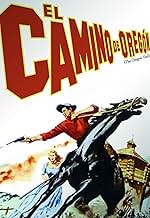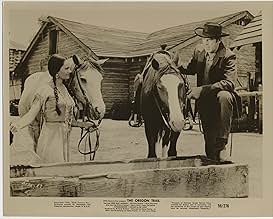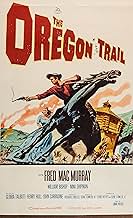Ajouter une intrigue dans votre langueIn 1846, a newspaperman joins an Oregon Trail wagon train to verify rumors about the U.S. government sending troops disguised as settlers there in order to claim Oregon.In 1846, a newspaperman joins an Oregon Trail wagon train to verify rumors about the U.S. government sending troops disguised as settlers there in order to claim Oregon.In 1846, a newspaperman joins an Oregon Trail wagon train to verify rumors about the U.S. government sending troops disguised as settlers there in order to claim Oregon.
- Réalisation
- Scénario
- Casting principal
Avis à la une
This American Western has a turbulent and mighty history , some of which is told in this story , along with some attractive Folk songs .Here is a panoramic view of the American West , concerning the dangerous travels, risked adventures, hazards, including Indian attacks , chavalry charges , Indian assaults on Fort Laramie and anything else .It is an epic movie photographed in Technicolor , but adding ridiculous Matte-painting .For the most part , it is a pretty ordinary drama about settling to the West , adding a brief intrigue about an uncovered Army official and a journalist played by Fred MacMurray .Particularly here stands out the motley group of actors, and special mention for a big main and support cast. Fred MacMurray plays a Newspaperman who falls for a beautiful Indian girl played by Gloria Hendry , while William Bishop falls for the attractive Nina Shipman, John Carradine as a settleman who spends the limited water by watering his plants , Henry Hull as the Wagonmaster Guide , John Dierkes as the nasty pro-Indian traitor , the elderly Elizabeth Patterson , James Bell, among others .
Aside from being predictable and regular story , the picture has a few pluses, such as Cinematography by Kay Norton , though being necessary a perfect remastering, as well as spectacular action scenes as Indians lay siege and attack Fort Laramie. Charming and catching musical score by Paul Dunlap , including wonderful songs as Ballad of the Oregon Trail, and , Never Alone composed by Paul Dunlap and Lyrics by Charles Devlan . The motion picture was regularly directed by Gene Fowler Jr. He was a prolífic producer , director and especially film editor . Directing some movies as Gang War , Showdown at Boot Hill , The Rebel Set , Here come the Jets ,I married a monster from Outer Space , I Was a Teenage Werewolf , and various episodes of famous TV series as Rawhide, The Waltons, Caliber 44 , Perry Mason , Assignment Underwater , Man with a Camara, Gunsmoke , among others. Rating 5/10 .Mediocre but passable .
Fred is the lead, though, working undercover to find secret bad guys, wooing women, and learning how to cope with dust in his trousers and sleeping on the dirt. If you're a fan, you'll like seeing him in this City Slickers-esque movie. Keep in mind it's not a comedy, though. There are some tense situations, trigger-happy grumps, and violin strings playing whenever Granny Elizabeth Patterson says she knows she'll make it through the entire ride. John Carradine portrays Johnny Appleseed, and there's a particularly sad scene when his trees get attacked. Personally, I found this movie too sad to be enjoyable. You might want to try the Lewis and Clark biopic The Far Horizons instead.
Things begin unpromisingly with a scene involving President Polk in Washington D.C. This scene tries to give the story a historical context but it's on the dull and talky side. This is followed by another lax scene in which dapper, man-about-town reporter, Fred MacMurray, is assigned to go west on a wagon train and write a story for his newspaper. Finally, as MacMurray arrives in Westport, Missouri -- the eastern start of the Oregon Trail -- things begin rolling. They do so in a conventional way, however, and the entire trek west is filled with the usual situations: troubling encounters with Indians, dry water holes, tensions among the folk on the wagon train, an unexpected rain storm, a funeral service by the side of the trail, a settler protecting his apple-tree seedlings, etc. The use of stock shots and indoor sets hamper the effects of many of these scenes and there's no real villain to conflict with Fred MacMurray. There's also no tension about his mission since he makes no effort to hide it and the possible romantic- triangle involving him and William Bishop and Nina Shipman never takes form. Instead, MacMurray is implausibly paired with Gloria Talbott who appears fairly late in the proceedings.
Action builds toward a last-reel Indian attack which now seems quite "politically incorrect." (The "half-breed" Indian girl implausibly says: "It is because of this, I renounce my people.") Perhaps the only notable thing about "The Oregon Trail" is the scene in which Indians capture Fred MacMurray, strip off his shirt, and stake him out to die. (For a man in his early 50s, MacMurray looks pretty good bare-chested!) While TV westerns often staged these stake-outs, they're not all that common in the movies, and who'd believe one of them would "star" an actor about to get a career boost by playing in Disney comedies?!
Its initial premise was suspect: sending a reporter on a five-month journey to check out rumours that soldiers in civilian clothing were accompanying wagon-trains. Neal Harris had no reliable means of getting his dispatches back to his editor, and if they had been printed they would have been dated; as it happened, his objectives were overtaken by events.
I can't see McMurray as a great ladies' man, even when he displays a sweaty chest. His flirting with President Polk's secretary (did he have a female secretary, I wonder), didn't convince, nor did his instant rapport with Shona.
After days of water shortage and dust, Prudence Cooper's hair looked remarkably well-groomed and there was a terrible lack of continuity when a settler took an arrow in his chest, only for it to appear in his back a couple of seconds later.
Plus points for John Carradine as the eccentric settler with his apple trees and for John Dierkes as mountain man Gabe Hastings.
Le saviez-vous
- AnecdotesThis was William Bishop's last role and last movie.
- GaffesIn scenes at the White House, President James K. Polk stands in front of a US map, but the map shows the US following the Compromise of 1850. The film is set in 1846, before the Texas border was changed, before the Mexican Cession resulted in the admission of California and the organization of the Territories of Utah and New Mexico, all of which are clearly seen on that map.
- Citations
Neal Harris: Questions seem to bother you a lot, Mr. Wayne.
Capt. George Wayne: Only the man who asks them.
Neal Harris: Well, that's too bad because my livelihood happens to depend on questions.
Capt. George Wayne: Then I suggest you go back East and ask them. Out here, questions can get you killed.
- ConnexionsReferenced in Les sièges de l'Alcazar (1989)
Meilleurs choix
- How long is The Oregon Trail?Alimenté par Alexa
Détails
- Durée1 heure 26 minutes
- Couleur
- Rapport de forme
- 2.35 : 1
Contribuer à cette page































